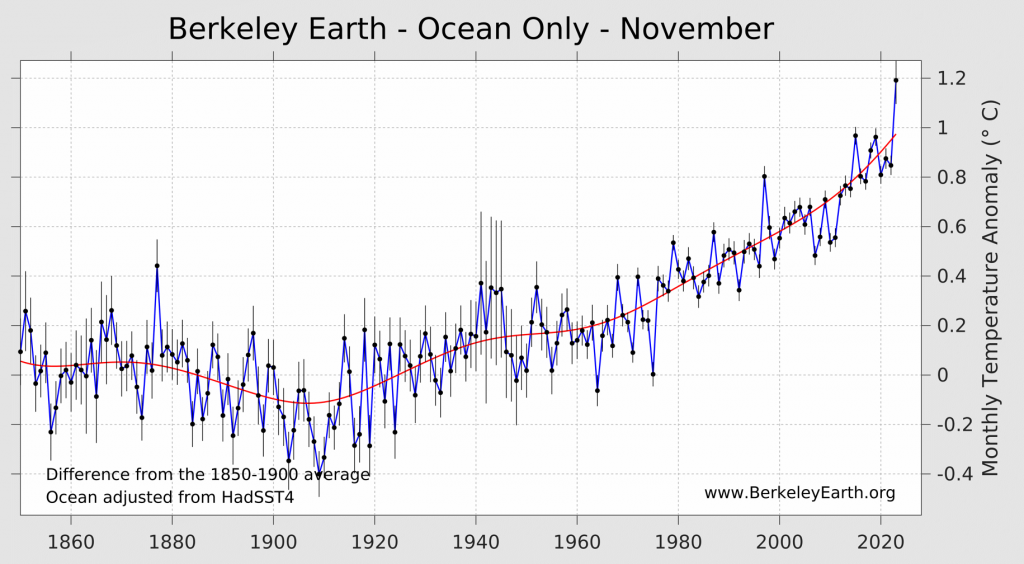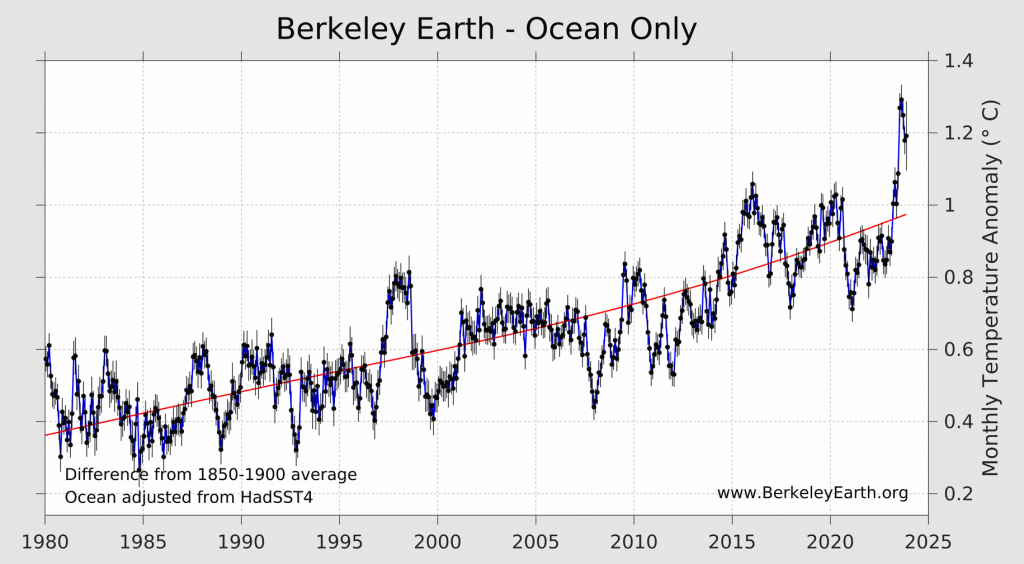The following is a summary of global temperature conditions in Berkeley Earth’s analysis of November 2023.
- Globally, November 2023 was the warmest November since records began in 1850.
- The previous record for warmest November was broken by 0.36 °C (0.65 °F), an unusually large margin.
- Both land and ocean individually also set new records for the warmest November.
- Record warmth in 2023 is primarily a combined effect of global warming and a strengthening El Niño, but other natural variability and man-made factors have also contributed.
- Particularly warm conditions occurred in the Central Asia, Northern Canada, North Africa, the Middle East, South America, parts of the Atlantic, and parts of the Indian Ocean.
- Unusually cold conditions were present in Northern Europe and Eastern Antarctica.
- 51 countries set new monthly average records for November.
- A strong El Niño is present and is expected to continue into next year.
- 2023 is now virtually certain to become a new record warm year (>99% chance).
- 2023 is virtually certain (99% chance) to average more than 1.5 °C above our 1850-1900 baseline.
Global Summary
Globally, November 2023 was the warmest November since directly measured instrumental records began in 1850, breaking the record previously set in November 2020. In addition, this November exceeded the previous record by 0.36 °C (0.65 °F), a large margin.
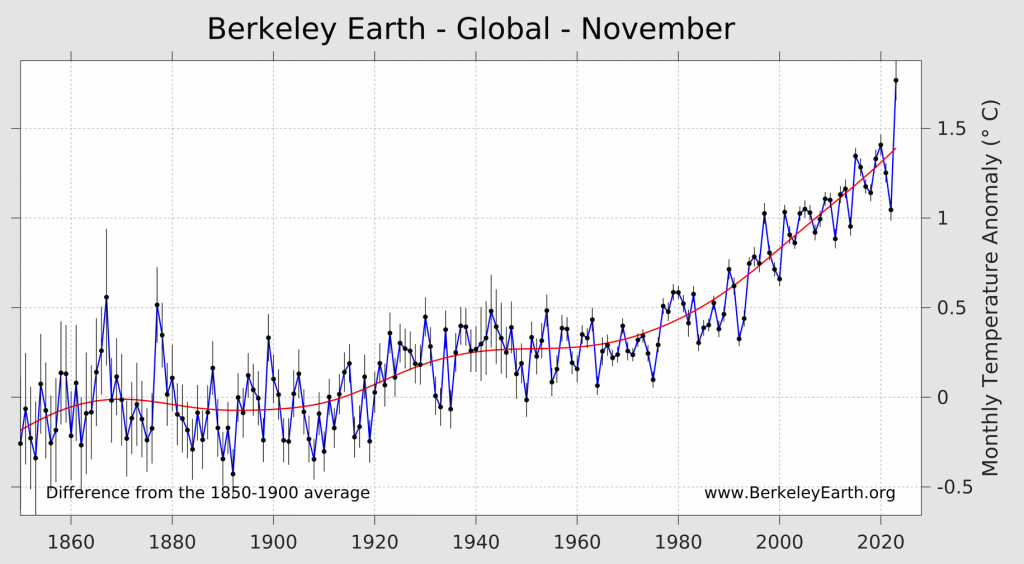
The global mean temperature in November 2023 was 1.77 ± 0.12 °C (3.18 ± 0.22 °F) above the 1850 to 1900 average, and the second largest anomaly ever observed behind only September 2023.
This is the 16th time in the Berkeley Earth analysis that any individual month has reached at least 1.5 °C (2.7 °F) over the preindustrial benchmark. This also previously occurred in March, July, August, September, and October of 2023.
One of the Paris Agreement ambitions has been to limit global warming to no more than 1.5 °C (2.7 °F) above the preindustrial baseline. That goal is defined in reference to the average climate over many years, so a few individual months or a single year above 1.5 °C do not automatically mean that the target has been exceeded. However, isolated anomalies above 1.5 °C are a sign that the Earth is getting close to that limit. It is likely that global warming will cause the long-term average to exceed 1.5 °C during the 2030s unless significant reductions in greenhouse gas emissions are achieved soon.
The last six months have been extraordinary in terms of global average temperatures, with new monthly records being set every month and by large margins.
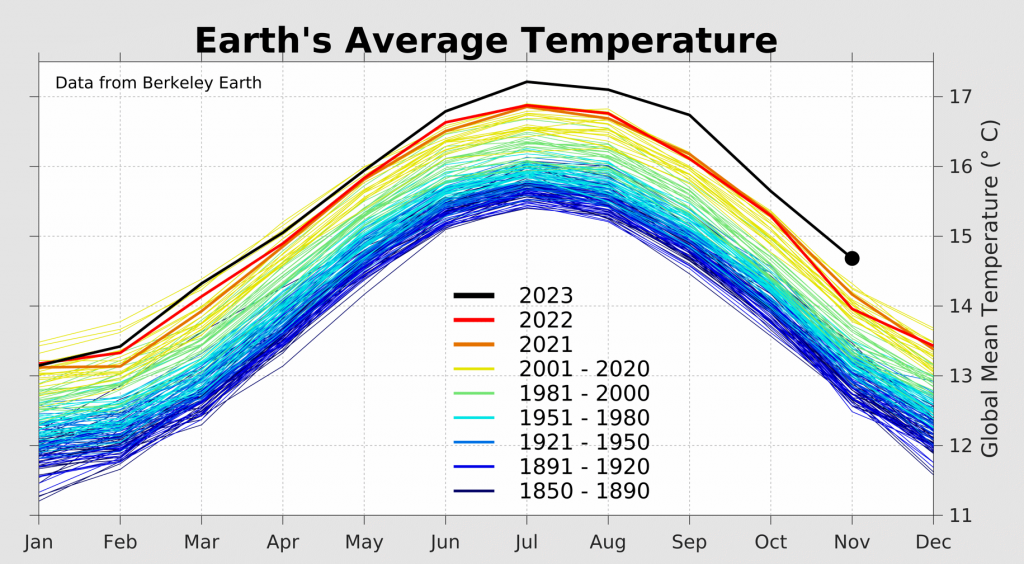
The global mean temperature anomaly in November 2023 slightly increased relative to October 2023, but remains below the all-time highest observed anomaly, which occurred in September 2023.
The last three months stand as the three largest single-month temperature anomalies in the period for which instrumental data exist, i.e. since 1850.
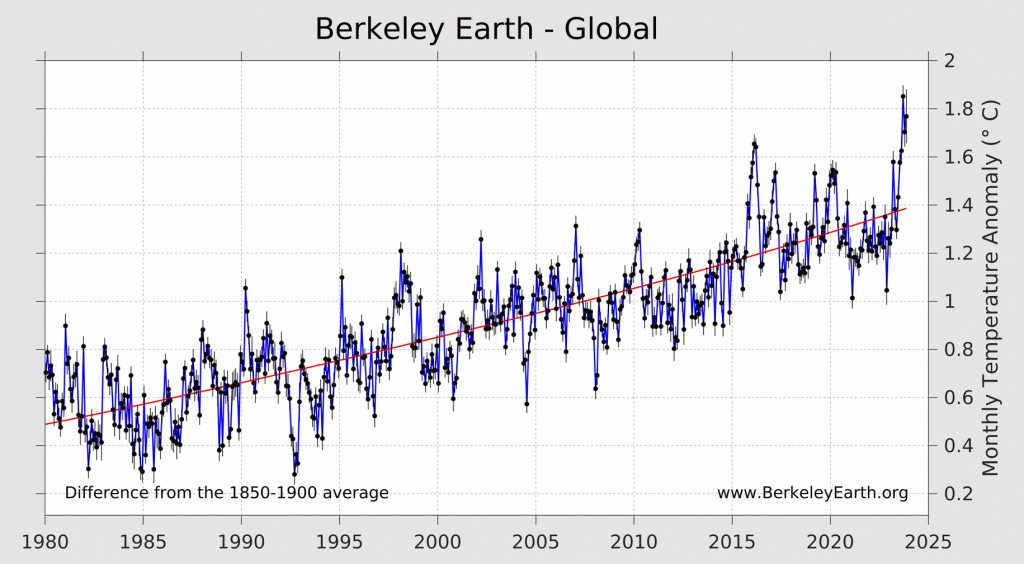
Spatial Variation
November 2023 continues the ongoing pattern of widespread warmth, with very few exceptions. Particularly warm conditions were present in the Central Asia, Northern Canada, North Africa, the Middle East, South America, parts of the Atlantic, and parts of the Indian Ocean. Unusually cold conditions were present in Northern Europe and Eastern Antarctica.
We estimate that 12.9% of the Earth’s surface experienced their locally warmest November average (including 17.3% of land areas), and 84% of the Earth’s surface was significantly warm when compared to their local average during the period 1951 to 1980. By contrast, 0.3% of the Earth’s surface had their locally coldest November.
The Equatorial Pacific in November shows strong El Niño conditions and has continued to strengthen modestly. An El Niño condition was officially declared by NOAA in early June.
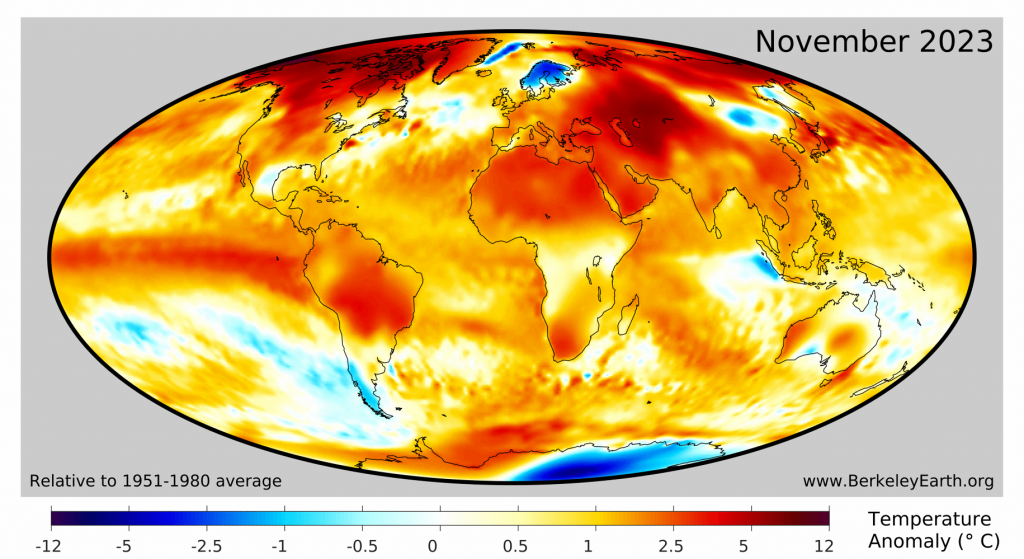
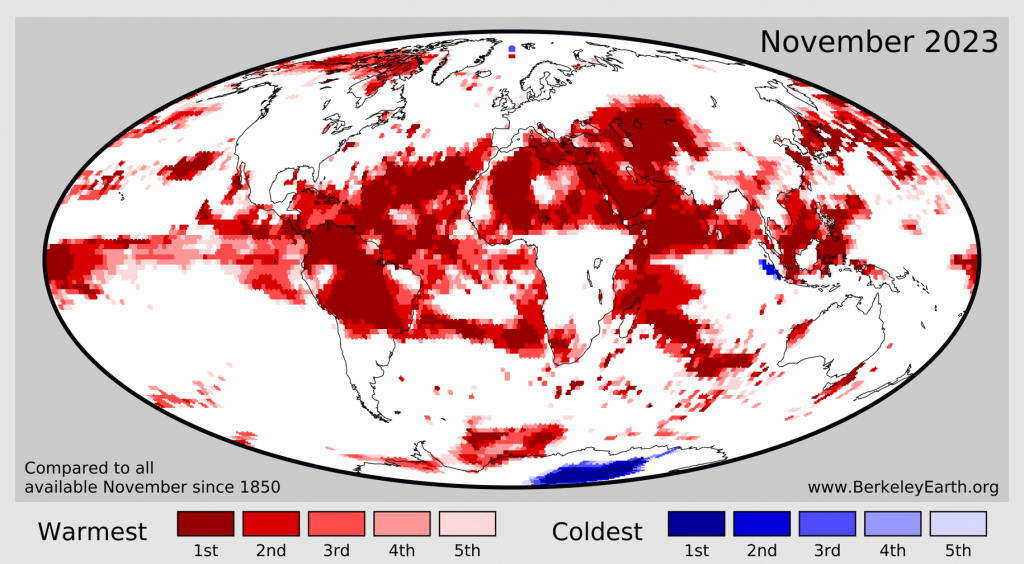
Over land regions, 2023 was also the warmest November ever observed by a large margin, and was similar to conditions in September and October. The land average was 2.56 ± 0.15 °C (4.62 ± 0.27 °F) above the 1850 to 1900 average. This sharply beats the previous record for November, which was held by 2020.

In total, we estimate that 51 countries had their warmest November on record, these were:
Afghanistan, Algeria, Antigua and Barbuda, Armenia, Azerbaijan, Barbados, Benin, Bolivia, Brazil, Burkina Faso, Cabo Verde, Colombia, Costa Rica, Cyprus, Djibouti, Dominica, Ecuador, Egypt, Eritrea, Georgia, Grenada, Guyana, Haiti, Iran, Jamaica, Jordan, Kazakhstan, Kiribati, Kyrgyzstan, Mali, Malta, Nigeria, Oman, Palau, Panama, Peru, Saint Kitts and Nevis, Saint Lucia, Saint Vincent and the Grenadines, Samoa, Saudi Arabia, Seychelles, Sudan, Syria, Tajikistan, Trinidad and Tobago, Tunisia, Turkmenistan, Uzbekistan, Venezuela, and Yemen
In addition, some of these countries broke their November records by extraordinary margins. In Azerbaijan, the November heat wave across Central Asia broke the November average temperature record by almost 1.9 °C (3.4 °F). In Bolivia, the November average temperature record was beaten by almost 1.5 °C (2.7 °F).

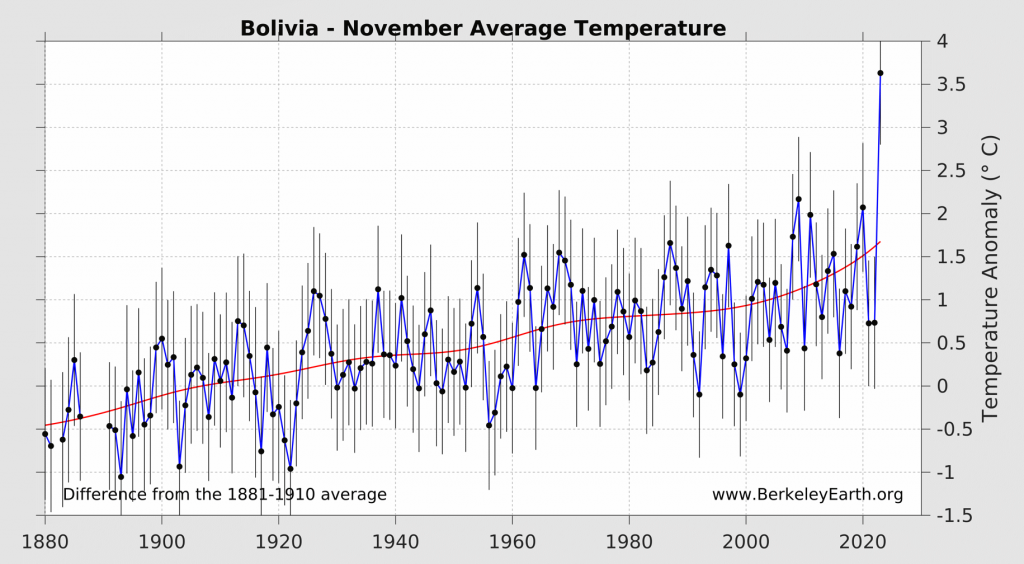
November 2023 was also the warmest November in the ocean average, recorded as 1.19 ± 0.11 °C (2.14 ± 0.20 °F) above the 1850 to 1900 average. This beats the previous record for November, which occurred in 2014, by a considerable margin.
The ocean temperature anomaly for November is modestly lower than July, August, and September, but still represents the fourth warmest monthly ocean temperature anomaly ever measured.
Seasonal Changes (September — November)
The last three months have been extraordinary. The El Niño associated warming developed somewhat early and joined by independent warming in the North Atlantic, and associated warmth in South America and Asia. This helped to create not only the largest September to November temperature anomaly ever observed, but also the largest deviation from the long-term trend in at least 100 years.
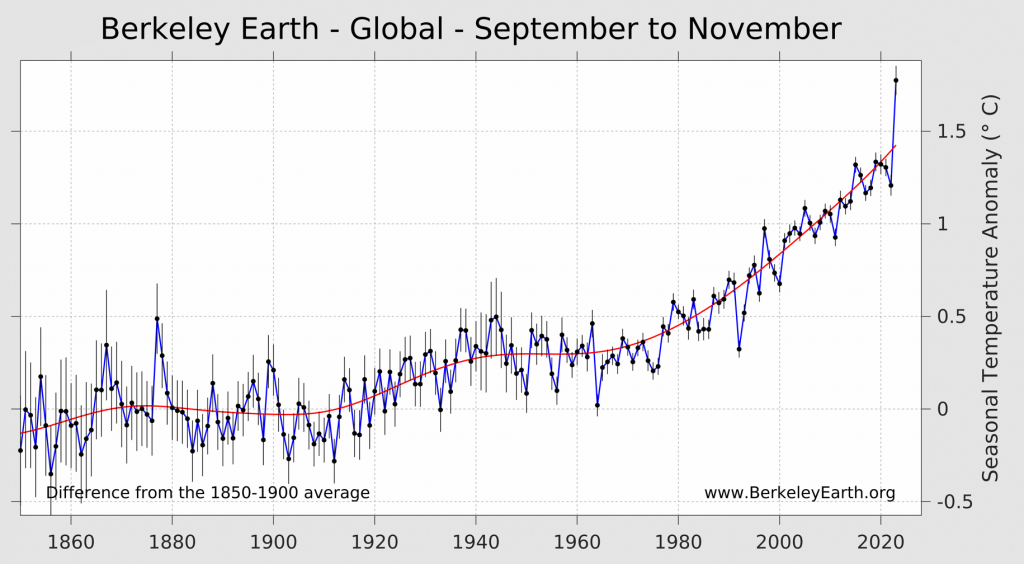
Record and near record warmth for this three-month average was observed across a large portion of the North Atlantic, South America, Europe, Africa, and Asia. In total 19% of the Earth surface had a September to November average temperature that was the warmest that has been observed. This included an enormous 32% of the land’s surface.
Only a small portion of Eastern Antarctica had near record cold during this same three month period.

Causes of Recent Warmth
The record warmth over the last few months is due primarily to the transition from La Niña to El Niño condition in the Pacific, which is a form of natural variability associated with short-term swings in global temperature. This short-term change occurs within a background of longer-term man-made and natural changes mostly also favoring warming during the present time.
Firstly, man-made global warming has been raising the Earth’s temperature by about 0.19 °C/decade (0.34 °F/decade). This is a direct consequence of the accumulation of additional greenhouse gases in the atmosphere, especially carbon dioxide. This is the primary factor responsible for long-term warming.
However, global warming is a gradual process. It does not explain short-term spikes and fluctuations in Earth’s average temperature. The main reason for such spikes is internal variability in the distribution of heat and circulation of the oceans and atmosphere. The largest and most well-known form of short-term internal variability is the El Niño / La Niña cycle originating in the Pacific. During the El Niño phase, global average temperatures tend to be somewhat higher. As a result, record highs for global average temperature tend to be set during El Niño years. This year, a new El Niño officially began in June after a multiple year period of La Niña. The rapid transition from a moderately strong La Niña to the current El Niño has played a large role in the warming this year.
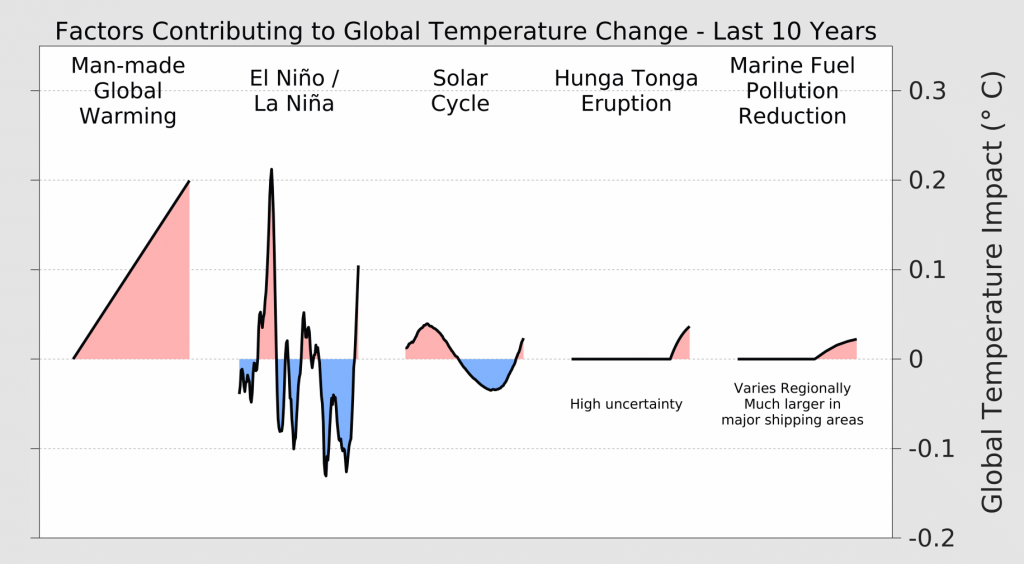
In addition to the natural El Niño variability, it is likely that other natural variability is also contributing to the extreme temperatures in 2023. One area of special interest is the North Hemisphere portion of the Atlantic Ocean. The last six months have been not only record warm in the region, but also the largest deviation from trend on record. If this change were entirely natural, the year-to-year warming spike in the North Atlantic would be at least a once-in-a-century event. However, in a previous discussion, we noted that warm anomalies in the Atlantic are likely to be combination of natural variability and man-made regional warming due to new marine shipping regulations that abruptly reduced sulfate aerosol pollution in this region.
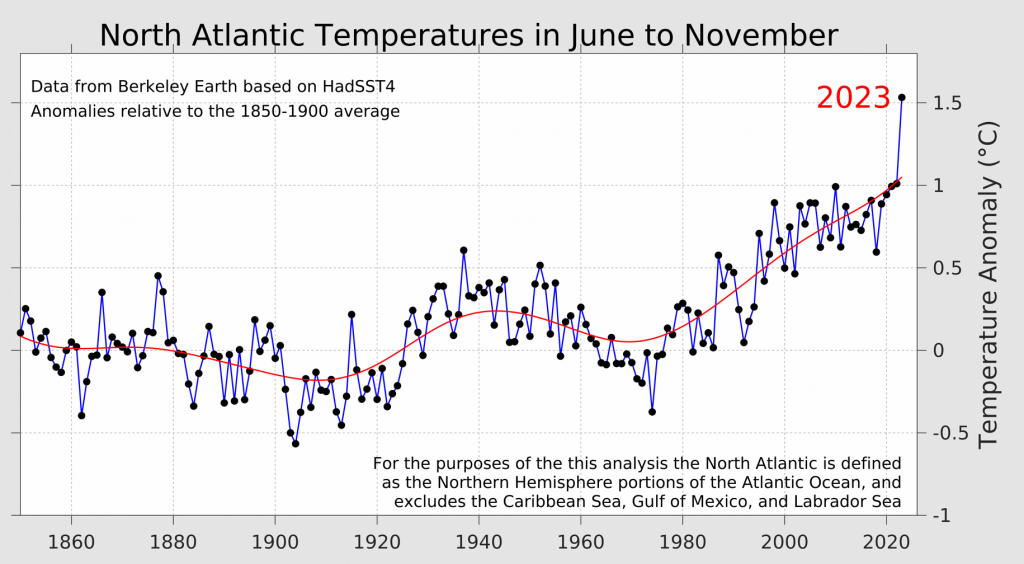
The combination of global warming and El Niño are the primary factors responsible for the present high global average temperature. However, other factors may also be playing a minor role. Some of these were discussed in greater detail in August’s temperature report.
El Niño Outlook
November 2023 saw a further modest strengthening of the new El Niño that began in June. The current CPC/IRI analysis suggests that El Niño conditions will persist until around Northern Hemisphere Summer 2024. The current El Niño is now categorized as strong, and is expected to peak during Northern Hemisphere Winter.
El Niño is likely to moderately boost global average temperatures during the end of 2023 and into 2024. Due to the lag between the development of El Niño and its full impact being felt on global temperatures, it is plausible that the current El Niño will have a greater impact on global temperatures in 2024 than it does in 2023. If other factors remain warm, such as the North Atlantic, that raises the probability that the annual average in 2024 could be even warmer than 2023.

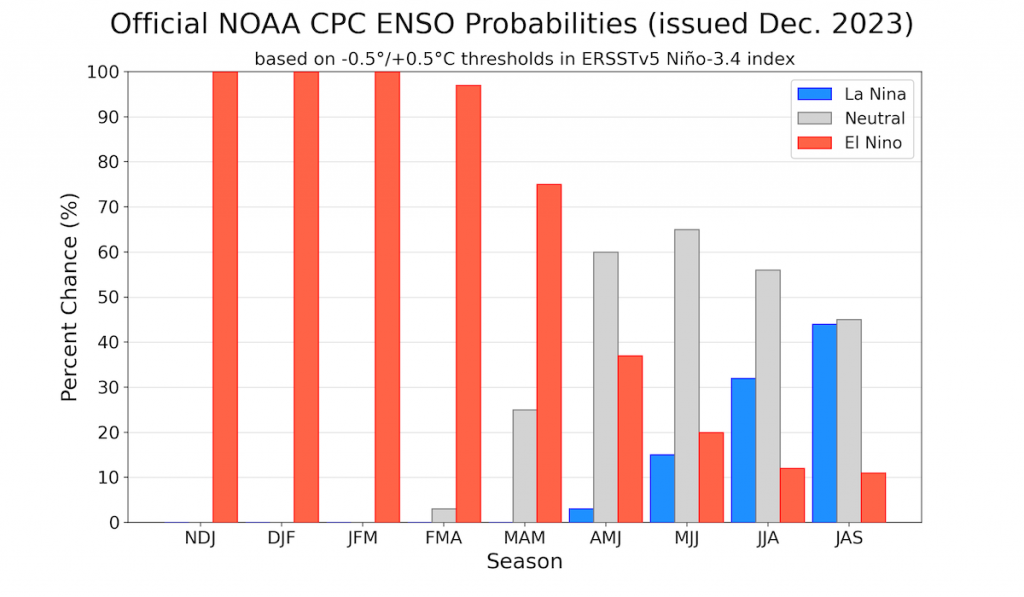
Year to Date
This year began with a January that was similar to January in 2021 and 2022. However, with the end of La Niña, temperatures diverged markedly in February and March, and are now far warmer than in any previous year in the historical record (i.e. since 1850). With the development of El Niño and record warmth in the North Atlantic, global average temperature in 2023 are running well ahead of any previous year.
June, July, August, September, October, and November each set new records for monthly average temperature in 2023, and mostly by large margins. As discussed below, we consider it essentially certain that 2023 will set a new record for the warmest annual average.
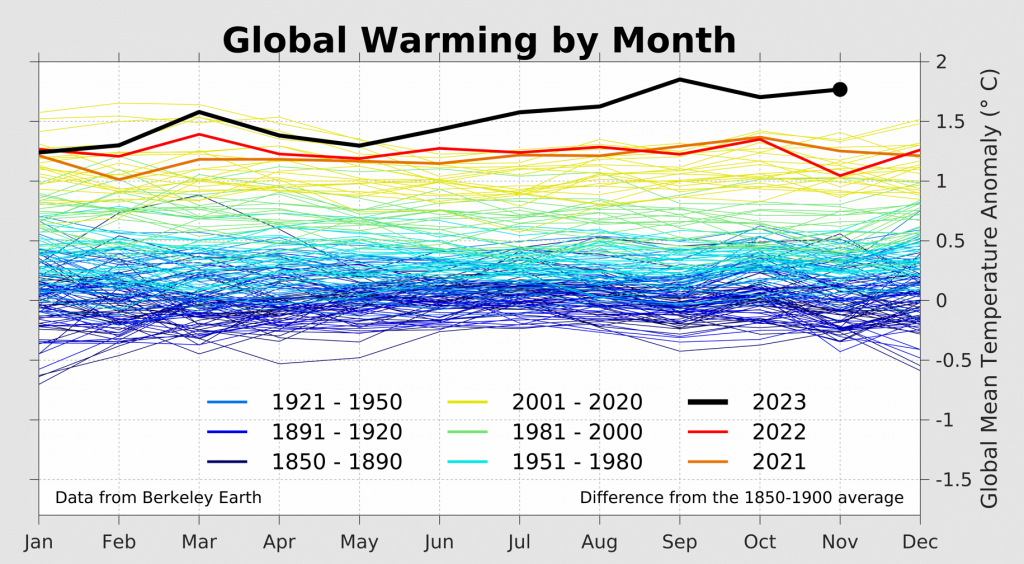
The most significant spatial features of year-to-date temperatures are the shift towards El Niño, warmth across much of the northern mid-latitudes, and several ocean hotspots (especially the North Atlantic). Year-to-date, 15.0% of the Earth’s surface has experienced average temperatures that are a local record high. In addition, none of the Earth’s surface has been record cold year-to-date.
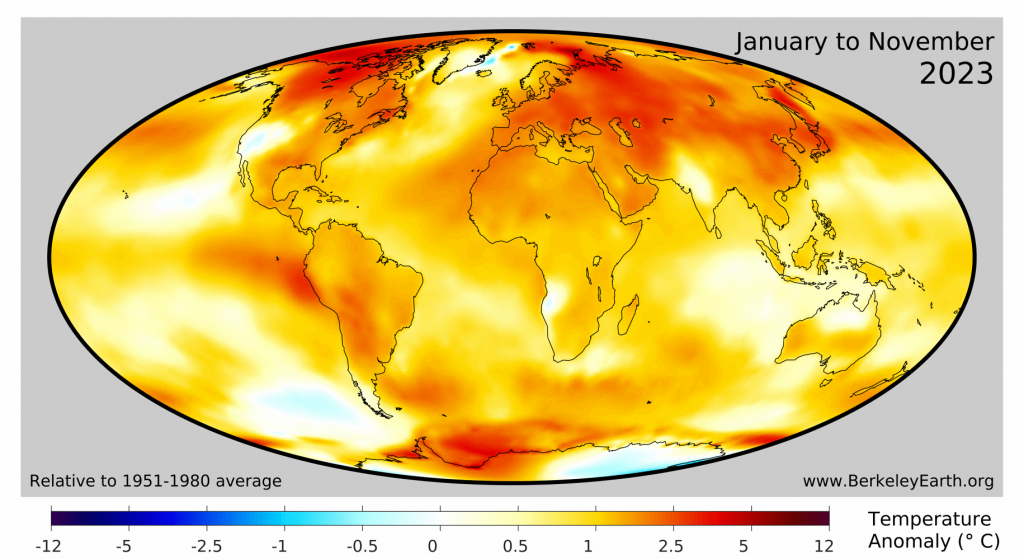
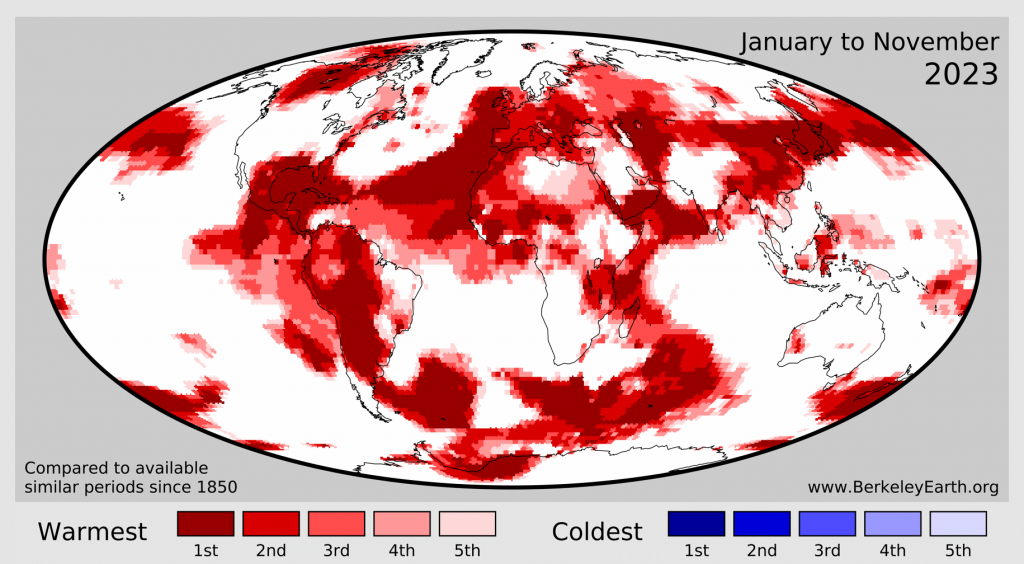
End of 2023
2023 will almost certainly be the warmest year since instrumental measurements began. Only an extraordinary intervening event – such as a large asteroid impact or a supervolcano eruption – could cool December enough to avoid setting a new record.
The statistical approach that we use, looking at conditions in recent months, now believes that 2023 is virtually certain to become the warmest year on record (>99% chance).

This forecast probability is essentially unchanged from the last four months, where we also forecast a 99% chance of an annual record. However, it represents a large change from the forecast at the beginning of the year (before the development of El Niño), when only a 14% chance of a record warm 2023 was estimated.
In this assessment, we also find it nearly certain that 2023 will result in both the warmest ocean-average year ever measured (>99% likelihood) and the warmest land-average year (>99% likelihood), boosted by global warming and the presence of El Niño.
The surprising warmth over recent months and the strong El Niño, raised our estimates for the final 2023 annual average. We now consider there to be a 99% chance that 2023 has an annual-average temperature anomaly more than 1.5 °C (2.7 °F) above the 1850-1900 average. Prior to the start of 2023, the likelihood of a 1.5 °C annual average this year was estimated at ~1%. The fact that this forecast has shifted so greatly serves to underscore the extraordinarily progression of 2023, whose warmth has far exceeded expectations.
Though the IPCC has set a goal to limit global warming to no more than 1.5 °C above the pre-industrial, it must be noted that this goal refers to the long-term average temperature. A few months, or a single year, warmer than 1.5 °C does not automatically mean that the goal has been exceeded. However, breaching 1.5 °C this year would serve to emphasize how little time remains to meet this target. Unless sharp reductions in man-made greenhouse gas emissions occur soon, the long-term average is likely to pass 1.5 °C during the 2030s.
Further, we should note that there exist small differences among groups in their assessment of long-term climate change. By a small margin, Berkeley Earth’s estimate of the 1850-1900 reference period is colder than most other groups. As a result, our estimate of the change since the preindustrial period is modestly larger. If 2023 exceeds 1.5 °C this year, it is likely to do so only by a small amount (around 0.05 °C). As a result, these differences between analysis groups are likely to become important. It is entirely possible that some groups will report 2023 as slightly above 1.5 °C while others report it as slightly below. Further discussion of the likely outcomes has been provided by Zeke Hausfather.

Because of the lag between the development of an El Niño and its maximum impact on global temperatures, an El Niño during 2023 may have an even larger warming effect on global mean temperature in 2024 than 2023. It is common for the second year of an El Niño to be warmer than the first year. Whether that ultimately holds true in 2024 may still depend on other factors, such as whether the North Atlantic also remains very warm or settles to a more normal temperature during 2024.

